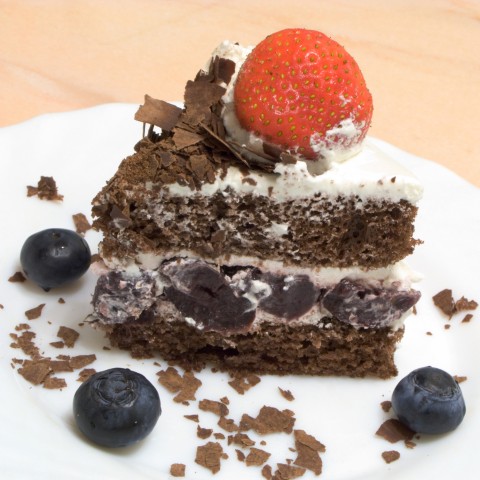
Maybe you weren’t fortunate enough to grow up with German restaurants nearby or German relatives in the family.
If not, you’ve missed out on some amazing food.
German food is soul food by any definition: rich, hearty, and packed with flavor. Anyone who’s been to Germany would probably agree that visiting restaurants was the highlight of their trip!
How well do you know your German food—and how well can you talk about it in German?
In this article, you’ll get to know some brand-new dishes as well as some that you’ve probably sampled before. All the while, pay attention to the words used to describe them and their German names. You might find yourself picking up some important German vocabulary!
 Table of Contents
Table of Contents
- Characteristics of German Food
- Must-Try Dishes in German Restaurants
- Authentic German Food vs. Overseas German Food
- Three Unique German Foods
- German Food Vocabulary
- Conclusion
1. Characteristics of German Food

Although many people in the United States and England can trace their ancestry back to Germany, there aren’t a ton of German restaurants on the streets of Miami or Blackpool. These people might not even have a great idea of what Germans typically eat!
At this point, you just need two words: Fleisch (“meat”) and Brot (“bread”).
It’s not all they eat, but these two items make up a large part of the traditional German cuisine. Kartoffeln (“potatoes”) make a solid appearance as well, though these aren’t technically an ancient European food.
Germans tend to avoid eating spicy food—they use pepper and vinegar sparingly, and rarely add sauces other than meat gravies. Slowly stewed meats and breaded cutlets often appear on German plates.
Sausages, of course, play a strong role in German cooking. Any German meat market will have more types of sausage available than you knew existed.
As for beverages, Germans don’t have a particularly strong tea or coffee culture, though beer, wine, and cider all flow freely at German restaurants.
Speaking of which, if you found yourself in a German restaurant right now, would you know what to order? There are quite a few types of German food you need to try!
2. Must-Try Dishes in German Restaurants

We’ll start off with a Southern German and Austrian specialty known as Spätzle. This is an egg noodle dish usually served with a hearty meat sauce. Once the dough for the noodles is ready, it’s held over boiling water and the drops of noodles are quickly sliced off, cooking nearly instantly as they become submerged.
Ready for dessert already? Some of the most famous German foods are desserts, like the Apfelkuchen (“apple cake”). You can find several variations of this sweet delicacy, such as the Gedeckter Apfelkuchen (“covered” with graham cracker crumbs and oats) or the Versunkener Apfelkuchen (with the apple bits “sunken” into a rich, spongy dough).
Again from Austria, next up we have the famous Strudel. This is a sort of turnover pie, normally baked with apples and raisins. The secret is to use absolutely paper-thin dough known as phylo, and to brush the whole thing with a small amount of butter before cooking.
You’ve heard of long German words—how about Schwarzwälderkirschtorte? Breaking this down, you can see what it really means: “black-forest-cherry-cake.” This thick, luxurious black cake is a centerpiece at many European bakeries, and that place of honor is well-deserved. For a true Black Forest cake, you need to make the cherry sauce and whipped cream by hand.
3. Authentic German Food vs. Overseas German Food

With so many Germans influencing culture the world over, it’s no surprise that lots of people are passingly familiar with German food. The key word is “passingly,” though. Plenty of things have gotten lost in translation as recipes have been handed down from generation to generation over the years.
So the question remains: What is traditional German cuisine and how does it compare to overseas varieties?
Chief among the foods in question might be the Brezel, or the German pretzel. In Germany, these are huge, curled knots of dough served piping hot with a dip of fresh mustard and sometimes topped with big flakes of rock salt. You don’t see a lot of those overseas, though. The typical “pretzel” that an American knows today is a tiny dried snack that comes out of a bag like a potato chip, baked into a hard crisp.
A schnitzel is another thing that looks a bit different overseas. According to culinary authorities in Austria and Germany, a Wienerschnitzel or Schnitzel Wiener Art (“schnitzel in the Viennese style”) must be made of veal—not pork or chicken. Since veal is about twice as expensive on average as pork and chicken, it’s no wonder people are cutting costs abroad! It should also be served in a light vinaigrette, not the heavy gravy that so many restaurants add.
Sauerkraut has been a popular stereotype of German cooking for generations, even lending its name to a not-very-polite epithet during the war years. It’s actually not a wholly German dish, originating in the Middle Ages from Eastern traders. Today, you can buy sauerkraut by the box in grocery stores all over the world, but few people keep to the simplicity of real German sauerkraut—it’s simply cabbage and salt, aged to perfection with no additives.
Finally, the Kartoffelsalat, or “potato salad,” is a beloved dish at picnics and get-togethers across the United States. It also differs quite significantly from what’s found in actual German restaurants, though. German potatoes tend to be smoother and more golden than potatoes in the Americas, and in preparing Kartoffelsalat, they’re boiled with beef broth for an extremely rich flavor.
4. Three Unique German Foods

Even though some popular German foods have been exported with differences from their original forms, there are still plenty more dishes to be discovered in German-speaking countries. Here are a couple of foods that are pretty hard to find elsewhere!
1. Weißwurst: Literally “white sausage,” this is a sausage made of veal and bacon, and it’s associated strongly with Southern Germany. It’s quite perishable and usually eaten as a breakfast or lunch food. The most interesting thing is the way it’s served—it’s brought to the table in the water used to cook it!
2. Sauerbraten: Just as the Wienerschnitzel mentioned above is usually served with vinegar, so too is this marinated roast. The meat is marinated for days at a time in vinegar and wine, and this marinade is later turned into a rich gravy. The whole thing is served with potatoes and red cabbage.
3. Currywurst: Perhaps you’ve already guessed what the name means after comparing it with Weißwurst above—it’s a curry-flavored sausage! Gastronomically speaking, a currywurst isn’t particularly gourmet. It’s a standard German bratwurst served with a mixture of ketchup and curry powder, often paired with french fries. However, it’s an absolutely beloved fixture of Berlin, and if you ever mention to a Berliner that you’ve never had one, expect to be marched to the nearest Imbiss immediately!
5. German Food Vocabulary

Now that you’re nice and hungry, it’s time for a bit of language practice. Do you know the right way to order food in German?
Believe it or not, when you go to a German café or bakery, the typical way to order is to simply count the things you want.
- Einmal Kaffee mit Zucker, zweimal Kekse bitte. / “One coffee with sugar, two cookies please.”
The word einmal literally means “once,” so you’re not ordering “one coffee” but “once coffee.” This is just a quirky turn of phrase. If you’re nervous about using it incorrectly, wait for someone else to order and confirm that you’ve got it right.
Although lots of the dishes mentioned in this article so far have been thick with meats and sauces, plenty of Germans are vegetarians. If you are too, it’s good to know how to ask about it.
- Haben Sie vegetarische Gerichte? / “Do you have vegetarian dishes?”
Although many German words sound a lot like English words, be careful of the false friend Menü. That’s the word for a “set meal,” while the paper with all the foods listed on it is a Spiesekarte.
- Können Sie etwas empfehlen? / “Do you have anything to recommend?”
And finally, at the end of the meal, it’s always a good idea to mention how good it was.
- Alles war fantastisch! / “Everything was fantastic!”
6. Conclusion
Has learning about German food gotten you hungry for more knowledge?
Ordering in a German restaurant can be a bit intimidating, but not if you’ve got the right practice materials. The best way to avoid having Germans speak English with you in restaurants is to be confident and speak clearly without stuttering. The more you show that you’re comfortable with the language, the more you’ll be accepted as a proficient German speaker.
And the best way to get there?
Naturally, by having a great resource at your fingertips! At GermanPod101.com, you can follow along with our high-quality podcasts. Our lessons range from those for learners at the raw beginner level to those for more advanced speakers of German. As you learn, you’ll naturally pick up grammar and vocabulary, and then have access to high-quality guides and interesting articles like this one to keep you motivated.
The sooner you start seriously learning German, the sooner you’ll master it. Much like cooking, practice makes perfect. Start today and add German to your chef’s repertoire!










